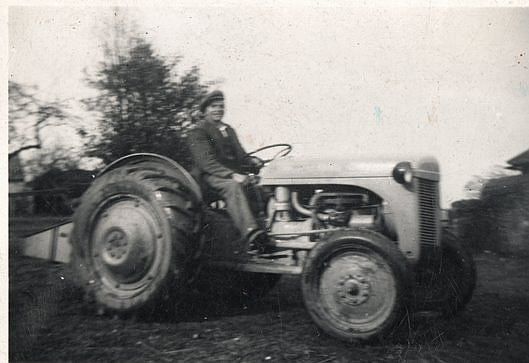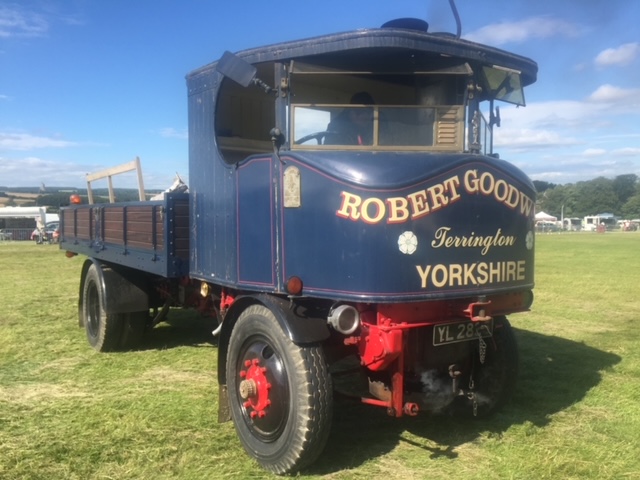Scaling Trailers and earlier blacksmiths

In 2022 the workshop and forge of Scaling Trailers in North Back Lane was demolished following the granting of planning permission for a house to be built on the site. Scaling Trailers was, for many years, the main industrial business active in the village but behind them stretched centuries of metalworking by blacksmith families who worked the nearby forges.
We tell first the story of the Scalings, the last family that worked the forge on Main Street. We’ll then go back and trace the earlier blacksmiths who served the parish throughout the 19th century and into the 20th. Though no earlier written records exist, it was a trade which will have been practised in the village since Anglo-Scandinavian times and probably long before that, in one form or another.
Fred Scaling was not a Terrington man, moving here in 1948 from Brecklands Farm, Great Edstone, Kirkbymoorside where he’d been a farmer and tractor driver who had moved into the maintenance of agricultural equipment. He came here with his wife Olwen and took over the blacksmith’s shop on Main Street, renting it from Castle Howard together with the whole rear plot. They lived nearby in Sunnyside, the end of a row of cottages also belonging to Castle Howard.

Work for farriers was becoming less and less as horses were being replaced on farms and by that time most of the work consisted of repairing agricultural equipment, such as harrows, whose repair would have required traditional blacksmithing skills.
The rear of the plot behind the blacksmith’s shop gives on to North Back Lane and came with a stone building, still there today, and a Nissen hut. In the early/mid-1950s the Scalings bought the plot running from Main Street to North Back Lane between Sunnyside and the village school with a house called ‘The Garth’, which became their home, and put up a substantial workshop behind the house.
The blacksmith’s shop on Main Street was kept mainly for storage until a larger storage building was put up at the back where the Nissen hut had been, at which point they bought the rear of the plot from Castle Howard and the blacksmith’s shop was sold off to become a dwelling, ‘The Forge’.
The workshop building covered about 270 sqm, consisting of a main workshop building of 13.3m by 12.2m, with steel frame, concrete floor, block walls, and pitched asbestos roof, with a pent roof extension on the north side of 10.2m by 9.5m, and a lean-to on the east side of 2.2m by 4.5m with an office.


The big new workshop was needed because Fred was diversifying the business: as well as maintaining and repairing farming equipment he built his first trailers for agricultural use. This followed the introduction of the Ferguson TE20 tractor (the ‘Little Grey Fergie’) with its hydraulic hitch system and Fred made his first trailer for local farmer Robert Goodwill. The dimensions of this were based on the Ferguson trailer that Robert already had. Subsequently, Robert bought a single axle 4.5 ton trailer and two tandem axle 10 ton trailers, one of which Robert junior still has.
When Fred's son Pete left school in 1964 he joined Fred in the business. The first item Peter himself constructed was a bale sledge for Robert Goodwill. Pete developed the trailers into the main part of what they did, renaming it 'Scaling Trailers'. Pete later made the body that Robert fitted to their 1927 Sentinel Super Steam Waggon.


At the height of the business they employed several people building trailers and a succession of local apprentices started their working lives with Fred and Pete.
Fred died in 1994 aged 81, but the business continued under Pete until he retired and closed the business.
The plot behind The Forge was eventually sold, the large storage building was demolished, and Tyverington House built on North Back Lane. Then the workshop itself behind ‘The Garth’ was sold with planning permission for a house to be built. Inside, in a corner of the workshop, there was still the remains of the forge.






Earlier blacksmiths
Blacksmiths would always have had an important role in the village: ploughs had to be made and mended, spades, picks, scythes and sickles needed making, nails were required for many jobs, and horses always needed shoeing. The village is built of stone and stone masons would have needed the services of the blacksmith, making and regularly sharpening their tools. Joiners, wheelwrights and shoemakers would also had much call on blacksmiths' services. Even into the 1930s the Rector recognised what a key and useful man the blacksmith was:
Have you horse that needs shoeing or ploughshare to mend?
Are you in a tight place? Then for whom do you send?
Is it help for the young ’uns? Or help for the old?
The send for Fred Fletcher – he’ll help you we’re told
Over the centuries Terrington probably had more than one blacksmith, serving the village itself and surrounding hamlets. The records we have all come from the 19th century onwards, from trade directories and census returns, from which we can piece together what may have been the heyday of smithing and farriering and its gradual decline.
Baines Trade Directory of 1823 lists one blacksmith in Terrington, William Roberts, who may have been the only one willing to pay for an entry in the directory as censuses from 1841 onwards show that there were a number of blacksmiths operating in the village.
The Roberts family at the Smithy

In the 1841 census there is still a William Roberts, blacksmith, aged 25, so too young to have been the William of 1823, but presumably his son. With him were two apprentices, one being his son Joseph, aged 15, and a journeyman, David Smith from Stillington. It can be worked out from the order of the census entries that the Roberts lived (and presumably worked) at the house overlooking the Plump now called Smithy House.
Joseph continued the business from his father and in 1851 and 1861 is described as ‘smith and farrier’, one of his apprentices being John Pilmoor who came from a family of blacksmiths in Kirkbymoorside. In 1861 Joseph’s son William, aged 16, is also a smith and farrier.
By 1871 Joseph has come to be described as a veterinary surgeon, as other farriers at the time often were, though we do not know if, in this capacity, he was able to treat more than just horses’ hooves. Joseph died in 1877 but his widow Frances carried on the business and is described in the 1881 census as a veterinary surgeon herself with servant James Pilmoor, blacksmith, another of the Kirkbymoorside family. Maybe Frances could deal with hooves but needed a blacksmith to do the shoeing and other aspects of the trade.
Also in the Roberts household in 1881 was John Packard Andrews, aged 30, another veterinary surgeon. John Packard had been born in Cookley, Suffolk in 1849, his father, Moses, being a farrier, but his family moved to Fordingbridge, Hampshire when John Packard was an infant and his father graduated to veterinary surgeon.
In the 1871 census, John Packard Andrews is shown serving 6 months hard labour in Hampshire County Prison, Winchester, for allegedly stealing 5 shillings from the till of a public house. He is described as a groom. In 1881, after moving to Terrington, he married Joseph and Frances Roberts’ daughter Anna and the couple lived in Terrington for the rest of their lives, having one daughter Nellie, baptised by Samuel Wimbush in 1885. In the 1905 Kelly’s directory, John Packard had the initials MRCVS (Member of the Royal College of Veterinary Surgeons) after his name. He was also a parish councillor. Anna died in 1908 aged 50 and John Packard in 1932 aged 82. Their memorial is immediately inside the cemetery gate on the right.
In 1891, the blacksmithing was continued on the property by William Vester and his apprentice son, also William. The house was later occupied by the Fletcher blacksmiths (see below) but it is not clear whether they were working a forge at The Smithy or at The Forge. No one living in Terrington today (2022) has any ancestral memory of a blacksmith being at Smithy House.
David Smith, the apprentice of 1841, meanwhile, continued as a blacksmith in the village from 1851 to 1891. It is difficult to pin down where he lived, but it may have lived somewhere in or near The Square or Mowthorpe Lane. Nor is it known where he worked: at Smithy House, at The Forge, or somewhere else on his own account maybe.
The Firbank family at the Forge

The Forge is just down Main Street from The Smithy. It was occupied from before 1841 until 1873 by John Firbank and his son John, blacksmiths.
From early on Firbank tools must have had a good reputation as George Goodwill who had emigrated to the United States and was working as a wheelwright in Philadelphia in 1831, requested, in a letter back to his brother and father in Terrington, to be sent ‘a V Chissell 5/8 wide to mortice hobs of John Firbanks make’ (personal communication from Sue Goodwill, Hovingham).
1861 seems to have been the high point of blacksmithing in the village, with 2 generations of Roberts, David Smith, 2 generations of Firbanks, plus John Jackson, aged 20, perhaps working for one of the others.
The younger John Firbank died in 1873, aged 35, unmarried, though his widowed mother seems to have continued to live in the property until after 1881.
In 1881 there was another blacksmith, George Brown, living elsewhere in the village but we don’t know where he would have been working.
The Fletchers

The census of 1901 shows William Fletcher, blacksmith, living at The Smithy, with his son Frederick as apprentice. William was born in Hovingham in about 1860 but Fred was born in Brotton, Cleveland. Although living at The Smithy, the Fletchers may have been operating at The Forge.
In 1911 William had 2 other Terrington lads as apprentices, George Lister aged 20 and David Jackson aged 15, while Fred was living in Skelton, Cleveland with wife Mary Jane (née Calvert) working as blacksmith at an ironstone mine. Skelton is very near to Brotton so presumably William had been working in the area when Fred was born in 1880.
William Fletcher’s first wife Annie had died in 1904 and is buried in the churchyard. In 1914 he married Annie Upex (née Goodrick), the widow of James Stokes Upex, head gardener at Wiganthorpe Hall.
William continued the business until his retirement around 1930, being described in trade directories from 1909 onwards as blacksmith and carrier, decreasing demand presumably leading to the need to diversify. Fred then took over as village blacksmith until his death in 1943, the year before his father died. Both William (retired from blacksmithing and now a farmer) and Fred appear in the 1933 Wimbush photos.

William Fletcher after retirement, with his second wife Annie (née Goodrick) and step-son George Upex. William was described as blacksmith & carrier emeritus, farmer and bowls player
Photo by James Wimbush, 1933

Fred and Mary Jane Fletcher and Mary Jane’s mother, Sarah Calvert. Fred was assistant secretary to the bowling club, Mary Jane a church councillor and on the village hall committee
Photo by James Wimbush, 1933

This photo of Fred Fletcher and James Wimbush taken in 1933 is inscribed with the verse:
Have you horse that needs shoeing or ploughshare to mend?
Are you in a tight place? Then for whom do you send?
Is it help for the young ’uns? Or help for the old?
The send for Fred Fletcher – he’ll help you we’re told
Photo in the James Wimbush collection, 1933, but who took it?
The information on this page about Scaling Trailers was kindly supplied by Pete Scaling with additional information from Robert Goodwill.
